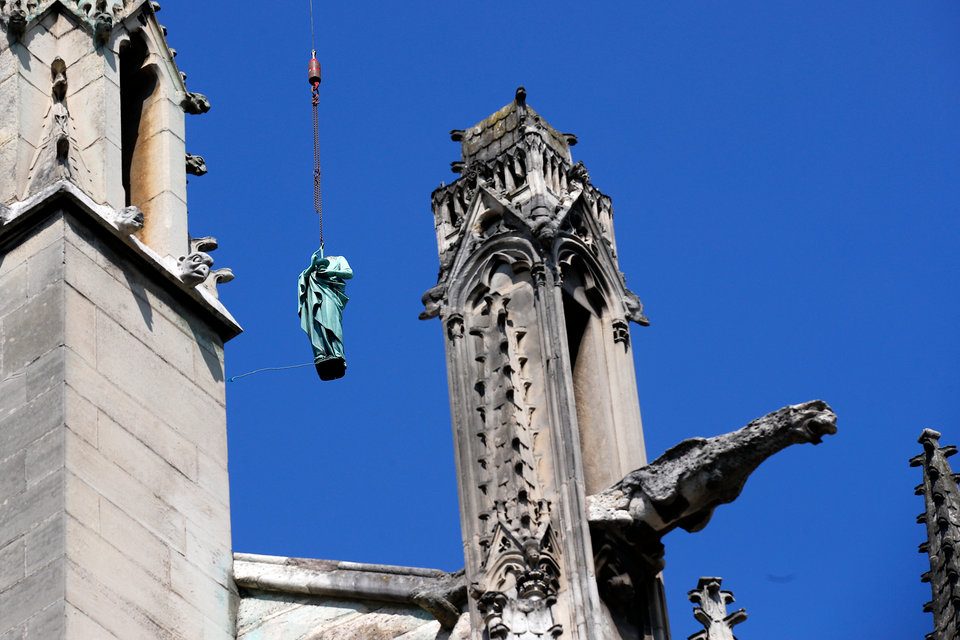16 Historic Statues Removed From Notre-Dame Cathedral 4 Days Before Fire
 The religious statue representing St. Paul is hoisted from the top of the Notre Dame Cathedral in Paris Thursday, April 11, 2019. / Photo Credit: Francois Mori, Associated Press
The religious statue representing St. Paul is hoisted from the top of the Notre Dame Cathedral in Paris Thursday, April 11, 2019. / Photo Credit: Francois Mori, Associated Press
According to the Associated Press, 16 historic statues were removed from the Notre Dame Cathedral just four days before the massive fire that destroyed a large portion of the building.
On April 11th it was reported that “Religious statues set atop Notre Dame Cathedral have come down for the first time in over a century as part of a restoration of the monumental Paris church’s towering spire. A 100-meter-high (105-yard) crane lowered the copper statues representing the 12 apostles and four evangelists onto a truck, giving the public a ground-level look for the first time on Thursday. The 3-meter-tall statues are being sent to southwestern France for work that is part of a 6 million-euro ($6.8 million) renovation project on the cathedral spire and its 250 tons of lead.”
 A worker helps to remove the religious statue representing St. Andrew from the top of Paris’ Notre Dame Cathedral. Photo Credit: Francois Mori Associated Press
A worker helps to remove the religious statue representing St. Andrew from the top of Paris’ Notre Dame Cathedral. Photo Credit: Francois Mori Associated Press
At the time of the fire, the cathedral was in the middle of a massive renovation project which was expected to cost at least €150 million or $169 million.
According to a 2017 article from the New York Times, Cathedral spokesperson André Finot said that the building was in desperate need of repair.
“Everywhere the stone is eroded, and the more the wind blows, the more all of these little pieces keep falling. It’s spinning out of control everywhere,” Finot said.
 The religious statue representing St. Paul is hoisted from the top of the Notre Dame Cathedral in Paris Thursday, April 11, 2019. / Photo Credit: Francois Mori, Associated Press
The religious statue representing St. Paul is hoisted from the top of the Notre Dame Cathedral in Paris Thursday, April 11, 2019. / Photo Credit: Francois Mori, Associated Press
Meanwhile, Reuters reported that the artworks taken from the Notre Dame Cathedral during the evacuation on Monday are being transferred to the Louvre Museum.
French Culture Minister Franck Riester told reporters that members of the fire department, the culture ministry, and the city townhall rushed into the Cathedral when the blaze started and did their best to protect the historic artworks that were inside the cathedral. Some of the historic works of art that were saved include Christ’s crown of thorns and French king Saint-Louis’s 13th century tunic.
While Paris public prosecutor Rémy Heitz said that his office would be conducting a “long” and “complex” investigation, he still says that they are “favoring the theory of an accident.”
French President Emmanuel Macron vowed to rebuild the historic cathedral, and as the church burned, wealthy donors from across the world began pledging their own money for the reconstruction. The donors have reportedly pledged about €600m or $677m thus far.
“We’ll rebuild this cathedral all together and it’s undoubtedly part of the French destiny and the project we’ll have for the coming years,” Macron said in a televised speech on Monday night.
French President Emmanuel Macron will hold a Cabinet meeting on Wednesday dedicated to the fire at Notre Dame Cathedral.
As of Tuesday morning, the fire was fully put out. Fire brigade spokesman Lt-Col Gabriel Plus told the BBC that the damage was bad, but would have been far worse had fire crews not arrived when they did.
“The whole of the roof has been devastated… a part of the vault has collapsed, the spire is no more,” Plus said.
However, Riester, France’s culture minister, warned that even though the principal structure had been saved, the building was still unstable.
The image below shows the full extent of the fire in its aftermath:
 Aftermath of Notre Dame Cathedral fire / Photo Credit: AFP Getty
Aftermath of Notre Dame Cathedral fire / Photo Credit: AFP Getty
At first, some people speculated that this could be an act of arson, but experts are now pointing to a construction fire as the reason for the blaze. Construction fires are sadly common during old church restorations, as Glenn Corbett, an associate professor of fire science at John Jay College in New York, explains.
“There’s a history of churches and synagogues and other houses of worship falling victim to construction fires,” he said.
The problem is that sparks from welders or open flames from torches can easily catch fire to the many flammable items in places like this. Plus, the old wood in building itself acts as kindling as well.
Experts say that the building was already in rough shape anyway, and was at risk of collapsing in the next ten years even if there wasn’t a fire.
© AnonLAB 2019